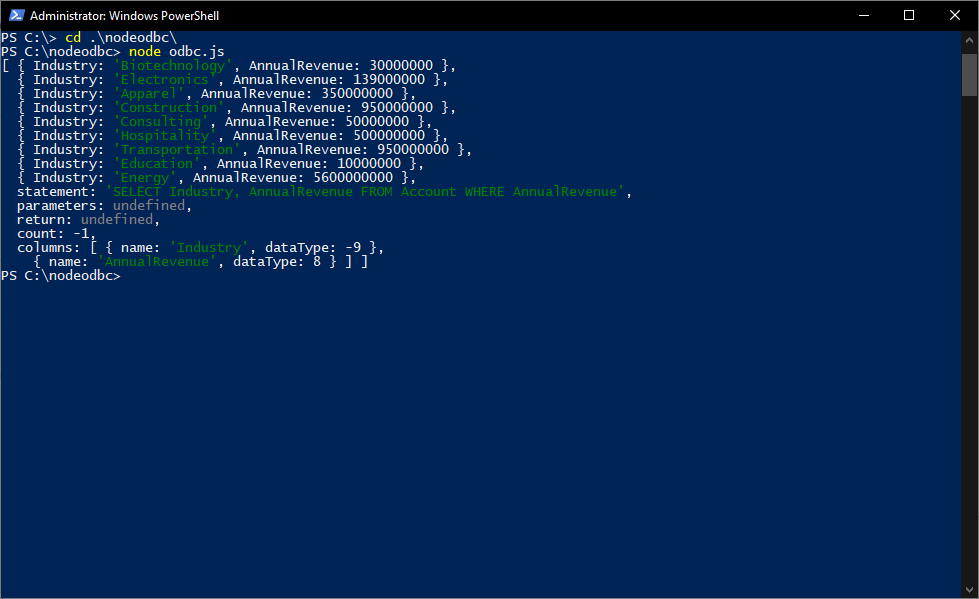Discover how a bimodal integration strategy can address the major data management challenges facing your organization today.
Get the Report →Query Certinia Data through ODBC in Node.js
Use node-odbc to execute SQL queries against Certinia data from Node.js.
Node.js is a JavaScript runtime environment that allows you to run JavaScript code outside of a browser. With the CData ODBC Driver for Certinia, you can access live Certinia data from Node.js apps and scripts. In this article, we walk through installing node-odbc and the required tools to create a simple Node.js app with access to live Certinia data.
With built-in optimized data processing, the CData ODBC Driver offers unmatched performance for interacting with live Certinia data in Node.js. When you issue complex SQL queries from Node.js to Certinia, the driver pushes supported SQL operations, like filters and aggregations, directly to Certinia and utilizes the embedded SQL engine to process unsupported operations client-side (often SQL functions and JOIN operations).
Connecting to Certinia Data
If you have not already done so, provide values for the required connection properties in the data source name (DSN). You can use the built-in Microsoft ODBC Data Source Administrator to configure the DSN. This is also the last step of the driver installation. See the "Getting Started" chapter in the help documentation for a guide to using the Microsoft ODBC Data Source Administrator to create and configure a DSN.
There are several authentication methods available for connecting to Certinia: login credentials, SSO, and OAuth.
Authenticating with a Login and Token
Set the User and Password to your login credentials. Additionally, set the SecurityToken. By default, the SecurityToken is required, but you can make it optional by allowing a range of trusted IP addresses.
To disable the security token:
- Log in to Certinia and enter "Network Access" in the Quick Find box in the setup section.
- Add your IP address to the list of trusted IP addresses.
To obtain the security token:
- Open the personal information page on certinia.com.
- Click the link to reset your security token. The token will be emailed to you.
- Specify the security token in the SecurityToken connection property or append it to the Password.
Authenticating with OAuth
If you do not have access to the user name and password or do not want to require them, use the OAuth user consent flow. See the OAuth section in the Help for an authentication guide.
Connecting to Certinia Sandbox Accounts
Set UseSandbox to true (false by default) to use a Certinia sandbox account. Ensure that you specify a sandbox user name in User.
Building node-odbc
In order to connect to Certinia through the CData ODBC Driver, you need to build node-odbc manually (after installing the required tools).
Installing the Required Tools
The following commands install the tools required to build node-odbc (note the -g parameter, which installs the tools globally).
npm i -g windows-build-tools npm i -g node-gyp
Building node-odbc
After installing the required tools, create a directory for the Node.js app and install odbc (which builds the binary for us to use in our Node.js script).
mkdir nodeodbc cd nodeodbc npm i -g node
Querying Certinia from Node.js
With the ODBC Driver installed, a DSN Configured, and node-odbc built, we are ready to query live Certinia data from a Node.js app. The sample code below connects to a specific DSN and queries the Account table.
myscript.js
const odbc = require('odbc');
async function queryCertinia() {
const connection = await odbc.connect(`DSN=CData Certinia Source`);
const data = await connection.query('SELECT BillingState, Name FROM Account');
console.log(data);
}
queryCertinia();
Once you write the app, use node to execute the script:
node myscript.js

Download a free, 30-day trial of the CData ODBC Driver for Certinia and start working with your live Certinia data in Node.js. Reach out to our Support Team if you have any questions.






